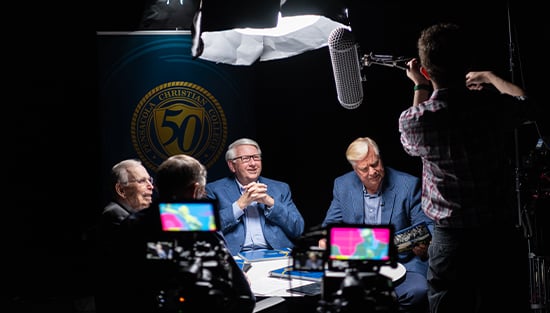
Advertising Services: Contributing to the Legacy
Throughout this year, PCC creatives in Advertising Services provided pieces that enhanced the 50th-Year Celebration.
Throughout the year, there’s always something happening at PCC, whether it’s a long-loved tradition or a brand-new event. Read up on our students as they engage college life, get to know our faculty, and celebrate alumni who are influencing their world for Christ.

Throughout this year, PCC creatives in Advertising Services provided pieces that enhanced the 50th-Year Celebration.

Seniors celebrated their class accomplishments with tacos, churros, and friendship bracelets at their Senior Class Fiesta.
Graduating students connected with faculty and administrators from 77 Christian schools at Educator Recruitment 2024.
PCC honors half a century dedicated to putting the Word of God first in the lives of future leaders.
This festive event helps students get into the Christmas spirit, but this season isn’t just about sparkly lights and hot chocolate.
Chamber Ensemble traveled to New York City to sing with Heather Sorenson at the historic music hall.
Honoring nearly 50 years of education, PCC hosts alumni seminars and forums that prepare and inform students for their future careers.
The pastoral ministries program prepares men to effectively preach the gospel while forging conviction and courage based on biblical truth.
Undergraduate and graduate winners at the ADDY Awards Gala are motivated to pursue a career in advertising design.
The Graduate Assistant Program provides advanced degrees, excellent work experience, and a paycheck instead of a tuition bill.
Seniors celebrated their class accomplishments with tacos, churros, and friendship bracelets at their Senior Class Fiesta.
The Lady Eagles, South Region champions, went on to the NCCAA DII Nationals for the 11th year in a row.
Students can earn financial assistance for the fall semester, gain workplace experience, serve, and create memories by working on campus over the summer.
Current students paused to consider the significance of February’s “extra” day by answering a few questions.
Training as a Navy pilot, Caleb Brown is trusting God’s leading to serve his country.
Believers young and old are encouraged and uplifted by Dr. Jim Schettler’s joyful countenance and thoughtful messages.
Dr. Richard Anderson teaches biblical truth and influences the next generation for Christ.
Dr. Grant De Jong teaches the importance of integrity in natural science fields and shapes the next generation of Christian scientists.
As Dean of Professional Studies, Dr. Donna Marion is invested in her team and seeks to help students succeed.
As Student Life deans, Dr. Brad and Mrs. Lee Ann Phillips consistently share their hearts with the student body.
Each semester, the Christian Service Expo connects students to ministries where they can grow spiritually and use their talents to glorify God.
This year, Student Body officers partnered with Campus Church to support the Christmas Project.
Some college students spent their summer reaching youth for Christ at YOM summer camps.
Staff, faculty, and students joined teams to share the gospel around the world.